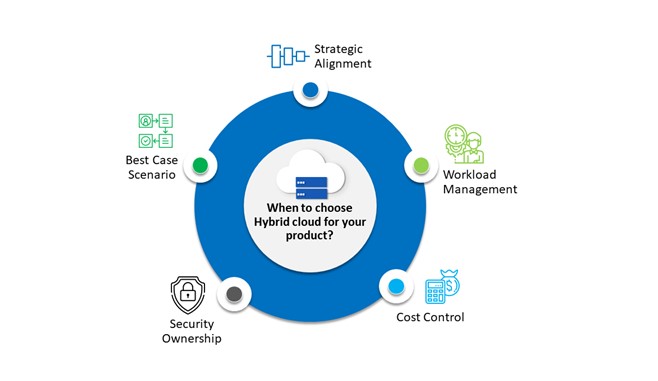



Siddhartha Bhattacharya, Sr. Solution Architect – Cloud & Emerging Technologies
Whether carefully planned or not, a hybrid cloud environment exists when an enterprise or an ISV consumes public cloud, private cloud, and on-prem services and infrastructure to support its business operations and/or product development. If this sounds suspiciously like multi-cloud, it’s because the structural components are the same with one major difference: hybrid cloud architectures provide policy-based and coordinated service provisioning, use and management across your internal and external cloud services – no need to purchase a multi-cloud management solution. Here, the instances can have multiple touchpoints, providing the independence and control to remain flexible, while preventing breaches or data loss. So why would I need a hybrid cloud plan and how would I start?
In this blog, we look at 5 hybrid scenarios for ISVs to consider for achieving the flexibility and control needed to quickly develop modern apps and features.
What makes Hybrid cloud appealing to ISVs?
These days hybrid cloud computing is trending with ISVs and their enterprise customers because it provides ample options and flexibility in terms of infrastructure, data protection, costs, and workload management.
"IDC predicts that digital transformation investment may reach $6.8 trillion by 2023 as organizations continue to develop their existing strategies and invest more in a digital-at-scale future enterprise."
Hybrid cloud, multi-cloud, containerization, cloud migration, and cloud-native development can enable ISVs to help enterprises meet their digital transformation milestones. However, the cloud enablement approach depends on the existing infrastructure for managing ISV product lifecycles. Furthermore, depending on strategic goals, hybrid models may vary from ISV to ISV or among enterprises. Some ISVs may prioritize workload optimization, while others may want to keep their critical data and resources on-premise and move non-critical or domain-specific resources to the cloud.
5 Scenarios for ISVs to Consider the Hybrid Cloud Approach

When should you choose a hybrid cloud to support your products? If you need help in finding an answer to this critical question, here are 5 scenarios to consider:
1. Strategic Alignment
The decision for an ISV to move workloads or infrastructure components from an on-premise to a hybrid cloud environment requires a well-thought-out strategy, including commitments and timelines for delivery of products, services, and ROI.
Whether an enterprise or an ISV, modeling the migration roadmap to enable ongoing alignment of specific business and technology imperatives helps ensure the initiative stays on track in terms of cost reduction and improved operations. BMC Control-M, for instance, can help manage data and job processing between on-prem and cloud systems for ISVs.
Also, evaluating hybrid model potential should include how fast a product's latest technology stack can be moved from development to production.
2. Workload Management
This is critical for any enterprise or ISV from the perspective of monitoring, expanding, and achieving 100% resiliency for workloads.
How to maintain workload efficiency as the business grows is a rising concern for ISVs. Mission-critical functions like data processing, analytics, storage, and automation must be stable and resilient. The organization will have to evaluate various operational data efficiencies to gain the insights needed to address growth forecasts, usage patterns, and gaps in its product offerings. To this end, data science and analytics become essential to decision-making.
Another aspect that is gaining prominence is the processing of services and service interactions. These are complex processes designed to make a product “complete” according to expectations and requirements. An ISV may choose to keep this intrinsic i.e. on-premise but, on a larger scale, the maintenance of such services and scalability factors does demand more investments, which can impact cost efficiency.
Hybrid cloud can minimize costs if an ISV chooses the right kind of cloud interfacing. For example, adding and removing compute instances based on service usages when the userbase grows can reduce costs. Cloud burst terminology is used when a business expects a surge and, based on the increase, can immediately rent the infrastructure and services, then resume normal operations when the surge ends.
|
Some effective tools for workload management and automation are the Equinix Digital Interconnection platform and BMC Control-M. These tools and solutions are available in the marketplace with key cloud service providers like Azure, AWS, and Google Cloud. The best part is, these framework solutions can be agnostic to multi-cloud and hybrid as well. While BMC Control-M lends stellar support for AWS Lambda and Step Functions, Azure Logic Apps offers a single pane of glass view. Equinix solves the issues of co-location and data analysis using the hybrid model and data on-demand. |
3. Cost Control
Cloud cost control usually depends on the services or infrastructure the ISV requires to support its product lifecycle operations. For example, if the ISV chooses an expensive, cloud-based data analytics service or tool, then it might not benefit unless the data volume is extremely large and the ISV's market comprises multiple global customers on the scale of a telecom giant.
However, if we look at day-to-day product usage, an ISV can use a monitoring service/dashboard to track spending on its cloud environment, which provides near-real-time data to optimize levels and timing of cloud spend.
On a hybrid model, there is no silver bullet that can achieve cost controls but rather, a combination of tools depending on the infrastructure. For example, for a recent project, the Xoriant team used a third-party cloud solution and a cloud-native billing offering like AWS Cost Management Services.
In our experience, some of the best cloud management solutions available today are CloudBolt, Replex, VMware CloudHealth, and Nutanix Xi Beam. Here, Nutanix provides an overall cost view for a hybrid model. To minimize Azure costs and enjoy a slew of other benefits, ISVs may want to assess Xoriant’s X·CELERATE Cloud Optimization solution.
4. Security Ownership
With a hybrid model, an organization may choose which data to move to the cloud and which to keep on-premise based on compliance and governance. Data protection has become a de facto requirement for any product offering, from disaster management to data loss recovery.
An ISV can always leverage critical data using its own BYOL (Bring Your Own License) and keys. This approach will ensure governance and compliance of data on the cloud while providing an additional layer of security for off-premises data. It also supports distributed data and disaster management workflows.
In these chaotic times, security concerns have begun to include cataclysmic-scale scenarios; how will the data be secured and recovered? What’s the backup plan for that?
Security is something that should always be a shared responsibility between the ISV and cloud provider. For example, AWS IAM is always plugged into the existing AD of the ISV for roles and the userbase; the same gets applied for third-party providers like Okta or Ping. The best case for using Okta or Ping is when the ISV product doesn’t require advanced security standards like MFA, 2 MFA, OTP-based authentication for resource grants, or for wearables like health bands.
5. Best Case Scenario
For ISVs as well enterprises, a hybrid cloud can provide fast ramp-up and ramp-down flexibility and reduce time-to-market with less overhead.
A product’s growth factor and time-to-market are key metrics for ISVs considering the hybrid cloud. If the ISV expects to have a huge spike in the coming quarters, it can confidently choose the hybrid model.
If there is even slight confusion as to whether to adopt the hybrid cloud model, here are a few bits of wisdom. It is not recommended to go hybrid if it could be risky from a cost ownership perspective, for example, if:
- the ISV has its own cloud space
- the ISV has workloads that can be managed efficiently for upcoming business runs
- the ISV's infrastructure is large and flexible enough to support growing business demands
- the ISV can manage the scalability of their business and product demand
- the ISV does not have an urgent need to reduce time-to-market
Conclusion
For most enterprises, and ISVs in particular, hybrid cloud can offer a greater spectrum of options and opportunities as to how to achieve a better revenue model and reduce infrastructure TOC. We also can’t stress enough how the added flexibility and resource savings can enable continuous innovation for a competitive edge in the coming year.
Is hybrid cloud suitable for your software product?
References:






 View Previous Blog
View Previous Blog




